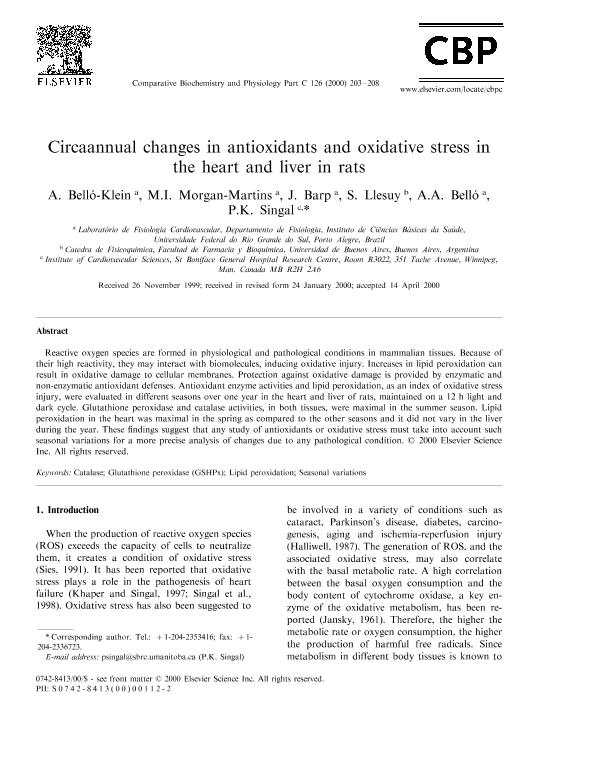Artículo
Circaannual changes in antioxidants and oxidative stress in the heart and liver in rats
Belló Klein, A.; Morgan Martins, M. I.; Barp, J.; Llesuy, Susana Francisca ; Bello, A. A.; Singal, P. K.
; Bello, A. A.; Singal, P. K.
 ; Bello, A. A.; Singal, P. K.
; Bello, A. A.; Singal, P. K.
Fecha de publicación:
06/2000
Editorial:
Elsevier Science Inc
Revista:
Comparative Biochemistry And Physiology. C, Comparative Pharmacology And Toxicology.
ISSN:
0742-8413
e-ISSN:
1878-1942
Idioma:
Inglés
Tipo de recurso:
Artículo publicado
Clasificación temática:
Resumen
Reactive oxygen species are formed in physiological and pathological conditions in mammalian tissues. Because of their high reactivity, they may interact with biomolecules, inducing oxidative injury. Increases in lipid peroxidation can result in oxidative damage to cellular membranes. Protection against oxidative damage is provided by enzymatic and non-enzymatic antioxidant defenses. Antioxidant enzyme activities and lipid peroxidation, as an index of oxidative stress injury, were evaluated in different seasons over one year in the heart and liver of rats, maintained on a 12 h light and dark cycle. Glutathione peroxidase and catalase activities, in both tissues, were maximal in the summer season. Lipid peroxidation in the heart was maximal in the spring as compared to the other seasons and it did not vary in the liver during the year. These findings suggest that any study of antioxidants or oxidative stress must take into account such seasonal variations for a more precise analysis of changes due to any pathological condition. © 2000 Elsevier Science Inc. All rights reserved.
Archivos asociados
Licencia
Identificadores
Colecciones
Articulos(IBIMOL)
Articulos de INSTITUTO DE BIOQUIMICA Y MEDICINA MOLECULAR
Articulos de INSTITUTO DE BIOQUIMICA Y MEDICINA MOLECULAR
Citación
Belló Klein, A.; Morgan Martins, M. I.; Barp, J.; Llesuy, Susana Francisca; Bello, A. A.; et al.; Circaannual changes in antioxidants and oxidative stress in the heart and liver in rats; Elsevier Science Inc; Comparative Biochemistry And Physiology. C, Comparative Pharmacology And Toxicology.; 126; 2; 6-2000; 203-208
Compartir
Altmétricas



